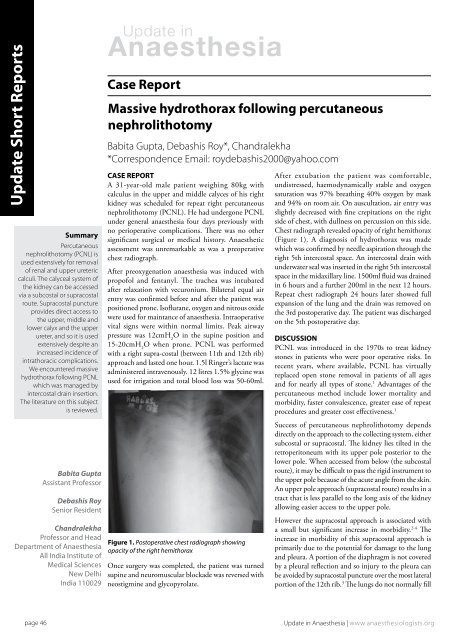Surgically placed rectus sheath catheters - The Global Regional ...
Surgically placed rectus sheath catheters - The Global Regional ...
Surgically placed rectus sheath catheters - The Global Regional ...
Create successful ePaper yourself
Turn your PDF publications into a flip-book with our unique Google optimized e-Paper software.
Update Short Reports<br />
Summary<br />
Percutaneous<br />
nephrolithotomy (PCNL) is<br />
used extensively for removal<br />
of renal and upper ureteric<br />
calculi. <strong>The</strong> calyceal system of<br />
the kidney can be accessed<br />
via a subcostal or supracostal<br />
route. Supracostal puncture<br />
provides direct access to<br />
the upper, middle and<br />
lower calyx and the upper<br />
ureter, and so it is used<br />
extensively despite an<br />
increased incidence of<br />
intrathoracic complications.<br />
We encountered massive<br />
hydrothorax following PCNL<br />
which was managed by<br />
intercostal drain insertion.<br />
<strong>The</strong> literature on this subject<br />
is reviewed.<br />
Update in<br />
Anaesthesia<br />
Case Report<br />
Massive hydrothorax following percutaneous<br />
nephrolithotomy<br />
Babita Gupta, Debashis Roy*, Chandralekha<br />
*Correspondence Email: roydebashis2000@yahoo.com<br />
CASE REPORT<br />
A 31-year-old male patient weighing 80kg with<br />
calculus in the upper and middle calyces of his right<br />
kidney was scheduled for repeat right percutaneous<br />
nephrolithotomy (PCNL). He had undergone PCNL<br />
under general anaesthesia four days previously with<br />
no perioperative complications. <strong>The</strong>re was no other<br />
significant surgical or medical history. Anaesthetic<br />
assessment was unremarkable as was a preoperative<br />
chest radiograph.<br />
After preoxygenation anaesthesia was induced with<br />
propofol and fentanyl. <strong>The</strong> trachea was intubated<br />
after relaxation with vecuronium. Bilateral equal air<br />
entry was confirmed before and after the patient was<br />
positioned prone. Isoflurane, oxygen and nitrous oxide<br />
were used for maintance of anaesthesia. Intraoperative<br />
vital signs were within normal limits. Peak airway<br />
pressure was 12cmH 2<br />
O in the supine position and<br />
15-20cmH 2<br />
O when prone. PCNL was performed<br />
with a right supra-costal (between 11th and 12th rib)<br />
approach and lasted one hour. 1.5l Ringer’s lactate was<br />
administered intravenously. 12 litres 1.5% glycine was<br />
used for irrigation and total blood loss was 50-60ml.<br />
After extubation the patient was comfortable,<br />
undistressed, haemodynamically stable and oxygen<br />
saturation was 97% breathing 40% oxygen by mask<br />
and 94% on room air. On auscultation, air entry was<br />
slightly decreased with fine crepitations on the right<br />
side of chest, with dullness on percussion on this side.<br />
Chest radiograph revealed opacity of right hemithorax<br />
(Figure 1). A diagnosis of hydrothorax was made<br />
which was confirmed by needle aspiration through the<br />
right 5th intercostal space. An intercostal drain with<br />
underwater seal was inserted in the right 5th intercostal<br />
space in the midaxillary line. 1500ml fluid was drained<br />
in 6 hours and a further 200ml in the next 12 hours.<br />
Repeat chest radiograph 24 hours later showed full<br />
expansion of the lung and the drain was removed on<br />
the 3rd postoperative day. <strong>The</strong> patient was discharged<br />
on the 5th postoperative day.<br />
DISCUSSION<br />
PCNL was introduced in the 1970s to treat kidney<br />
stones in patients who were poor operative risks. In<br />
recent years, where available, PCNL has virtually<br />
re<strong>placed</strong> open stone removal in patients of all ages<br />
and for nearly all types of stone. 1 Advantages of the<br />
percutaneous method include lower mortality and<br />
morbidity, faster convalescence, greater ease of repeat<br />
procedures and greater cost effectiveness. 1<br />
Babita Gupta<br />
Assistant Professor<br />
Debashis Roy<br />
Senior Resident<br />
Chandralekha<br />
Professor and Head<br />
Department of Anaesthesia<br />
All India Institute of<br />
Medical Sciences<br />
New Delhi<br />
India 110029<br />
Figure 1. Postoperative chest radiograph showing<br />
opacity of the right hemithorax<br />
Once surgery was completed, the patient was turned<br />
supine and neuromuscular blockade was reversed with<br />
neostigmine and glycopyrolate.<br />
Success of percutaneous nephrolithotomy depends<br />
directly on the approach to the collecting system, either<br />
subcostal or supracostal. <strong>The</strong> kidney lies tilted in the<br />
retroperitoneum with its upper pole posterior to the<br />
lower pole. When accessed from below (the subcostal<br />
route), it may be difficult to pass the rigid instrument to<br />
the upper pole because of the acute angle from the skin.<br />
An upper pole approach (supracostal route) results in a<br />
tract that is less parallel to the long axis of the kidney<br />
allowing easier access to the upper pole.<br />
However the supracostal approach is associated with<br />
a small but significant increase in morbidity. 2-4 <strong>The</strong><br />
increase in morbidity of this supracostal approach is<br />
primarily due to the potential for damage to the lung<br />
and pleura. A portion of the diaphragm is not covered<br />
by a pleural reflection and so injury to the pleura can<br />
be avoided by supracostal puncture over the most lateral<br />
portion of the 12th rib. 3 <strong>The</strong> lungs do not normally fill<br />
page 46<br />
Update in Anaesthesia | www.anaesthesiologists.org
















